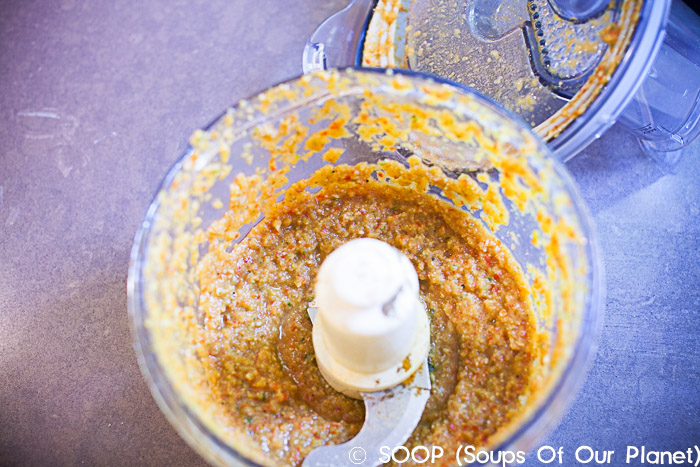PERU: Sopa Minuta
 We were super excited to draw Peru out of the cup just a couple of weeks before we were to leave for 3 weeks in Peru! We had a FANTASTIC time and saw, learned, and experienced so much – including hiking the Inca trail where the boys earned from the various guides on the trail the nickname “Alpacitos” (baby alpacas – as opposed to baby goats) as they scampered along.
We were super excited to draw Peru out of the cup just a couple of weeks before we were to leave for 3 weeks in Peru! We had a FANTASTIC time and saw, learned, and experienced so much – including hiking the Inca trail where the boys earned from the various guides on the trail the nickname “Alpacitos” (baby alpacas – as opposed to baby goats) as they scampered along.
While the boys love exploring Cusco – a city full of Incan history, colonial balconies, and (very) thin air… …they both REALLY loved Lima – a city full of gorgeous buildings, ceviche, public parks, and (the pièce de résistance) an arcade in the mall across the street from the hotel we stayed in. They want to move there… to the hotel that is. I wouldn’t mind either. (Shout out to Christian from the JW Marriott… if you’re reading this – you made our stay in Lima so fun! So fun connecting with another foodie!)
…they both REALLY loved Lima – a city full of gorgeous buildings, ceviche, public parks, and (the pièce de résistance) an arcade in the mall across the street from the hotel we stayed in. They want to move there… to the hotel that is. I wouldn’t mind either. (Shout out to Christian from the JW Marriott… if you’re reading this – you made our stay in Lima so fun! So fun connecting with another foodie!)

See that flag above the boys? It’s on the hostel I stayed in 20 years ago. We stopped in to see if they still have peacocks on the roof. Yes, they do. Also, the boys were beyond fascinated by the crypts under the yellow church (Catedral San Francisco) and the hundreds of thousands of bones on display. Boys.
One of the highlights of our trip was visiting a small farming village about an hour outside of Cusco where 32 families live and farm at 14,000 feet elevation. The primary language is Quechua (the language of the Inca) and many of the children don’t have the opportunity to attend school as they are busy working the fields. That said, there is an organization there now that has set up a fantastic school (one room, 40 kids ranging from 6-16, one teacher!) where the kids are learning to read and write in Spanish and English, taught computer skills, and provided a safe space to learn and study. It was amazing and humbling to see what the teachers and kids are able to accomplish with so little. That said, they need so much and we will be publishing a list of their needs and how you can help these kids. Stay tuned for more information.

The boys in red next to Beckett are the same age as him. Look how TALL Beckett is by comparison! The local boys were fascinated by the “giant boy in glasses”.

While we visited the school, the moms prepared a lesson for us in sheering sheep + alpacas, making yarn, dying the yarn and lastly weaving the materials.
If any of your are planning to travel to Peru with your kids, I have so much advice! Just send me an email and I’ll send you all my thoughts.
THE MEAL:
 Alrighty, on to the soup. We chose “Sopa Minuta” a classic soup loved throughout much of Peru for it’s ease, simplicity, and speed. It is found on menus all over the country and know by most everyone. That said, as we traveled through different parts of the country, the boys would make new friends and chat them up about our soup project and the response was invariably, “oh yes, Sopa Minuta is good, but you should really make……”. In fact, one hotel we stayed at, even surprised us by giving us a recipe to add to our roster. So sweet!
Alrighty, on to the soup. We chose “Sopa Minuta” a classic soup loved throughout much of Peru for it’s ease, simplicity, and speed. It is found on menus all over the country and know by most everyone. That said, as we traveled through different parts of the country, the boys would make new friends and chat them up about our soup project and the response was invariably, “oh yes, Sopa Minuta is good, but you should really make……”. In fact, one hotel we stayed at, even surprised us by giving us a recipe to add to our roster. So sweet!
 So, we just might have to repeat Peru a few times until we find our favorites. We’ll have to add “Quinua Soap” (aka Quinoa Soup), Chupe de Quinoa, and Moraya (dried potato soup). Look for those soups at some point during this project.
So, we just might have to repeat Peru a few times until we find our favorites. We’ll have to add “Quinua Soap” (aka Quinoa Soup), Chupe de Quinoa, and Moraya (dried potato soup). Look for those soups at some point during this project.
Anyway, like I said, Sopa Minuta is made all over the country and is made differently by each household- much like chicken noodle soup here in the US. We had it a few times in different places in Peru and it was drastically different – some include tomato sauce, some milk; some include ground beef, others chunks of sirloin. That said, the common ingredients are noodles (I use rice noodles to make it GF), beef, oregano, and a Peruvian chile paste made from aji panca. If you can’t find it in any of your local Hispanic markets, you can purchase it online. It is not spicy, but provides THE flavor for the soup. There is no substitute, so do yourself a favor and find a jar somewhere because once you try this, you will want to make it over and over. Plus, you can use it in the “quinua soap” recipe above. 🙂
This soup comes together in about 15 minutes and is hearty and filling enough for a quick weeknight meal. Pair this with a little salad (and maybe a pisco sour or two) and you’re all set!
Ingredients
- 2 teaspoons neutral oil – sunflower, canola, etc
- 1 small yellow onion, finely chopped
- 2 cloves garlic, minced
- 2 tablespoons tomato paste
- 2 tablespoons aji panca paste
- 1 pound ground beef – or sirloin cut into cubes if your prefer
- 1/2 tablespoon of salt
- 1/2 teaspoon freshly ground black pepper
- 1 teaspoon ground oregano
- 6 cups hot water
- 2 tablespoons GF tamari – or regular soy sauce if you can eat it
- 1/2 pound angel hair pasta (I use THIS brand and cannot tell it’s not regular pasta).
- 2 eggs
- 1/2 cup heavy cream
Preparation
- Heat oil in a skillet over medium heat. Add onion and garlic and saute about 8 minutes or until golden brown. Add tomato and aji panca pastes and continue to cook for another 5 minutes.

- Crumble the beef into the onion mixture and cook, stirring occasionally, until cooked through.

- Pour hot water into the mixture and add soy sauce simmer for 10 minutes.
- Add the noodles and cook for 4 minutes.

- While noodles are cooking, crack eggs into a cup and stir until well blended. (Make sure you don’t accidentally get shells in there!) Then gently stir eggs into soup – stirring continuously. Eggs will form long thin noodle like strings (like an egg drop soup).



- Remove from heat season the mixture with oregano and salt + pepper (to taste).

- Add cream and serve.
Cook’s Notes
This recipe ended up on all of our favorites list and will be on repeat at our house frequently. It’s very savory and comforting. My #1 of all so far!


























































